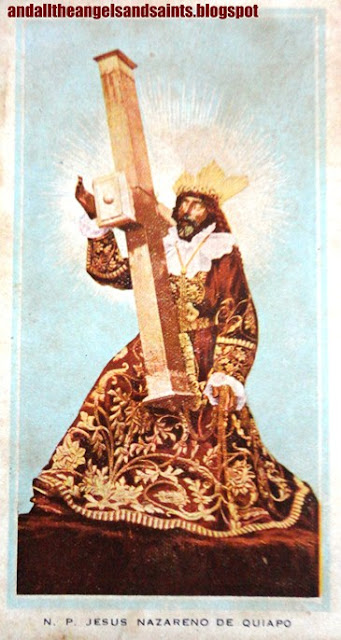 |
| JESUS NAZARENO OLD ESTAMPITA, |
Every year, in January, Quiapo becomes the center of fervent
religious attention during its fiesta. The devotion revolves around a dark,
life-size, cross-bearing image of Nuestro Padre Jesús Nazareno (Poóng Itím na
Nazareno) that is enshrined in the district’s minor basilica.
The image comes out thrice in a year—on New Year’s Day,
on January 9, and on Good Friday. The Januaray 9 “prusisyon” is the largest of
the three, when the re-enactment of the image’s solemn transfer (Traslacion) to
the basilica from its original location in what is now Rizal Park.
Religious veneration of the Nazareno—so-called because Jesus
is identified as having come from Nazareth, in Galilee is profoundly rooted among Filipinos who identify with Christ’s
sufferings as represented by the statue.
The black Nazareno image was brought here in a Mexican
galleon which sailed from Acapulco. It was carved by an unknown Mexican
sculptor in the mid-1600s. Its dark color
is not due to the black fumes of votive candles, or to being scorched by fire
that occurred in the galleon as widely
believed,--but because of the dark mesquite wood used.
Because the Nazareno had attained national popularity as
early as the 18th century, it has inspired replicas all over the
country. The older and more popular copy belonged to the Recoletos, but this was
destroyed during the last War.
Today, practically every church in every Philippine town
has a Nazareno image, many of which are also antiques. Outside of Quiapo, there
are similar “Traslacion” processions
being carried out, using official replica images—like the one in Cagayan
de Oro.
 |
| Photo courtesy of Dr. Raymund Feliciano |
 |
| Photo courtesy of Dr. Raymund Feliciano |
While Quiapo has become the focal point of homage to Christ,
the Nazarene, its fiesta has also become a season for all men, for all
Filipinos, a nation of worshippers still coming to grips with the conflict of God-inspired rituals and
human chaos.















The Nazareno Image of Polo, not in Maysan Valenzuela is still can be seen during the Lenten Observance and Holy Week Processions of the Old Parish of Polo.
ReplyDelete